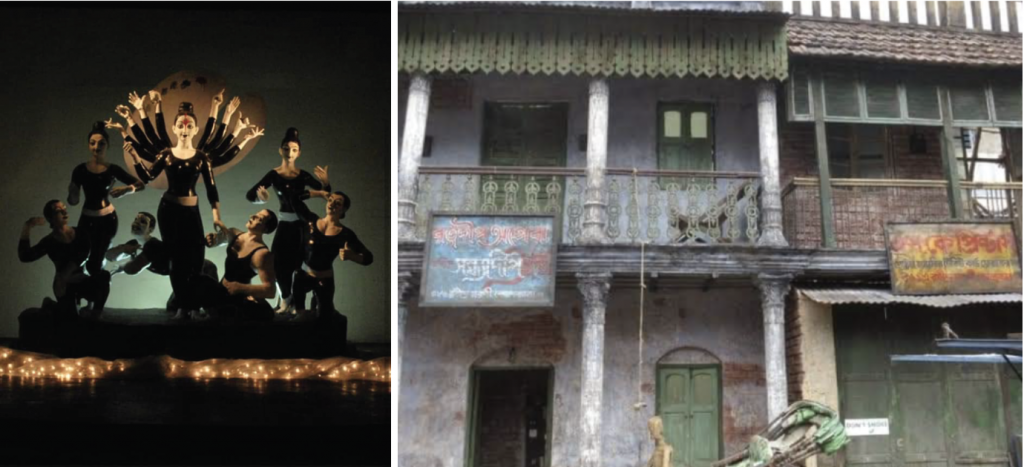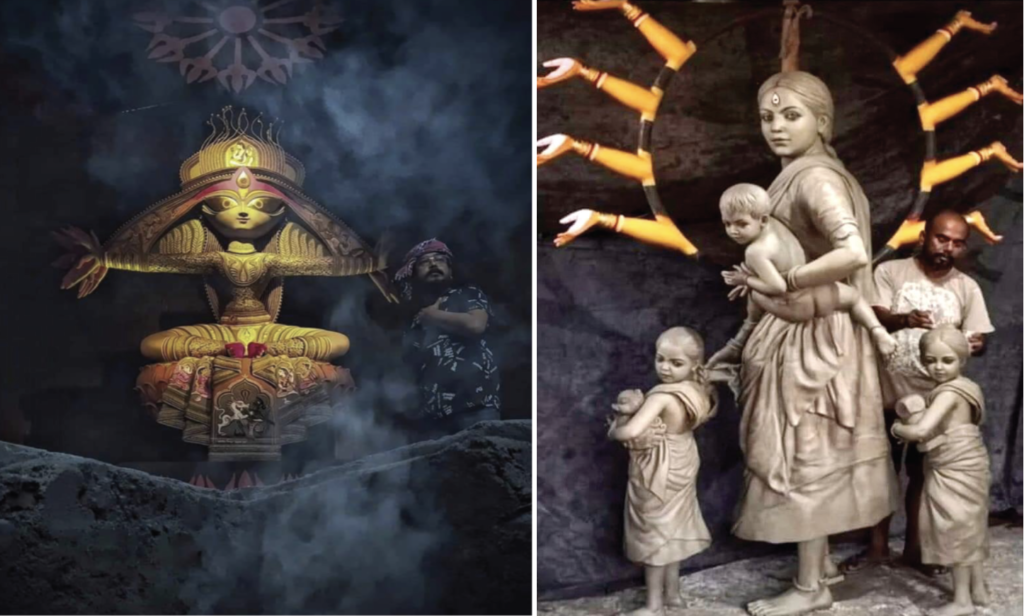Over the years Durga Puja celebrations have changed. At the core it is all the same – new clothes, gifted or purchased, community celebration, five-day feasting of vegetarian and non-vegetarian cuisine and varioucultural programmes funded by donations and sponsors. At the centre of it remains the pratima or Mother Goddess Durga, with her four children Lakshmi, Saraswati, Ganesh and Kartik housed in a beautiful mandap.
Earlier the idols were very much the same; draped with rich silk brocades, colours of which defined their identity. If Durga was clad in flaming red, Lakshmi was in pink and Saraswati in lime green. As crafted in clay by the kumour or potters of Kumortuli, in north Kolkata, they were in the ekchala style; that is, all in one frame or decorated with shola. As budgets grew due to corporate sponsorship, and a sense of competitiveness crept in – Durga Puja became a spectacle – a carnival as it were. Trained artists and sculptors gave a blueprint vision and executed these respectively. Interior designers then gave a “total look” of the mandap or pandal as it is known here.
Social themes inspire artists
It would be difficult to pin down the year in which one began to notice a change. Some puja associations started innovating with themes, materials and creativity. Various designers got involved and artists first did the blueprint and then executed these projects with the help of lights, artisans and decorators.
Some stand alone artists such as Aloke Sen had started sculpting Durga idols in the mid-eighties, which depicted several social themes. His depiction of corrupt politicians surrounding the main image of Durga was one. Similarly, where earlier the mandap was extraordinary craftsmanship of ordinary craftsmen, who created minarets, domes and spires of bamboo and cloth, today these are turnkey projects with budgets running into lakhs of rupees, even crores.
Sanatan Dinda is an artist who shot to fame having sculpted the statue of Mother Teresa. He has done a very traditional image of Durga this year. Rupchand Kundu is another trained artist and he has caught the imagination of the public in a big way with some outstanding work. Since these idols are immersed on Dussehra or Vijaya Dashami, the 10 th day of Navratri festival because it is believed keeping back idols bring bad luck, the structures too need to be dismantled. But for five days or more there is unbridled joy in enjoying these for which you do not require to buy a ticket to view.
Kundu who graduated from Kolkata’s Government College of Art, says, “I have to first survey the area and space to see what can be done.” His replica of an old house of North Kolkata was a big draw in 2018. The mansion was so realistic that it showed dirt and grime on the walls and the look was brought about by artisans under his supervision.
Kundu who has designed the seven wonders of the world in the new Ecological Park, Kolkata, has been an art/set designer for several well-known serials. He has even made two films on the entire process of idol crafting. Watching these, one wonders how little we know of the craftsmanship hiding behind poverty of such artisans. While the city sleeps, the wet clay is gathered from the banks of the River Ganga and ferried across in boats to the Baghbazar ghat or the river bank, close to which is Kumortuli. The sculpting begins thereafter. However, thanks to this annual festival stretching up to include Lakshmi Puja and Kali Puja coinciding with Diwali, the artisans are seeing better days. Idols are shipped outside the city as well.
Virtual tour of mandaps
This year there is a ban on entry into the mandap but work was commissioned earlier hoping that the corona vaccine would be discovered. But for now, everyone has to settle for a virtual tour or pictures.

designed as mandap by Kundu in 2018
“This year, I am not working on a single project due to budget cuts,” says Kundu, who is primarily an installation artist. His inspirations are many. Admirers still recall the installation works in mandap he did a few years back. He had used steel chairs, locks and keys in his work. What makes his structures unbelievable is that they are replicated with such precision. The effect of marble and stone are brought about by thermocol, fibre glass, cloth and jute, when not clay.
Connoisseurs of art look forward to their work as they would for exhibitions of well-known artists. Every year, the inspirations change for the artist. For those who are socially conscious, they work on social themes that are topical. Like Rintu Das this year. He is one artist who is inspired by Bikash Bhattacharya’s canvasses of Ma Durga and has created the look of her as a migrant woman labourer. With one child on her lap and two others in tow, another one is in the lap of one girl as is usually the scenario. We recognise Goddess Lakshmi holding a toy owl in her hand. The sculptor here is Pallab Bhowmik.
Whether it is the ordinary idol maker by profession or someone like Kundu who has been an artist for over three decades, Durga Puja celebration is about artistic expressions. Whether you look upon HER — the Goddess as a divine force or the girl next door, the artists and the artisans evoke respect and love. Says activist and writer Sudarshana Chakraborty, “Durga Puja, Bengal’s biggest carnival, is beyond a religious event. It is inclusive and marks the homecoming of the daughter and is a celebration of womanhood and motherhood.”
To that one may add it is all about, renewed hope, beauty, love and art in life.


